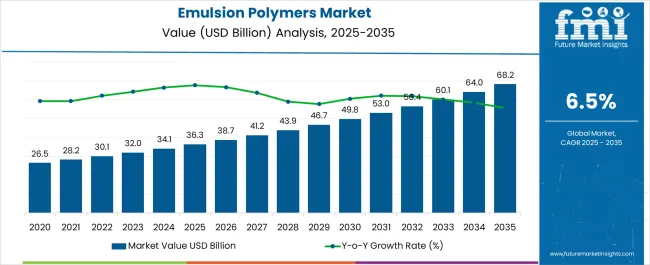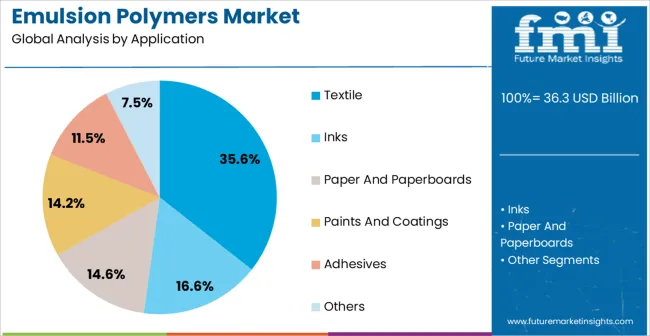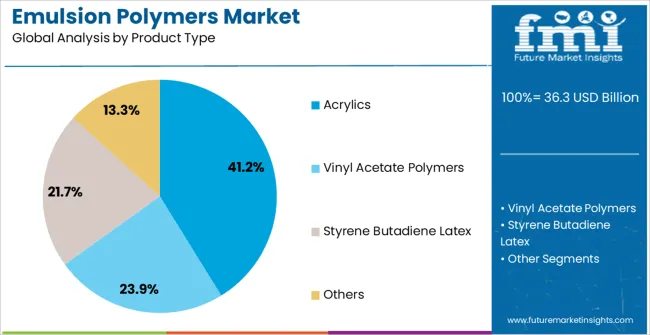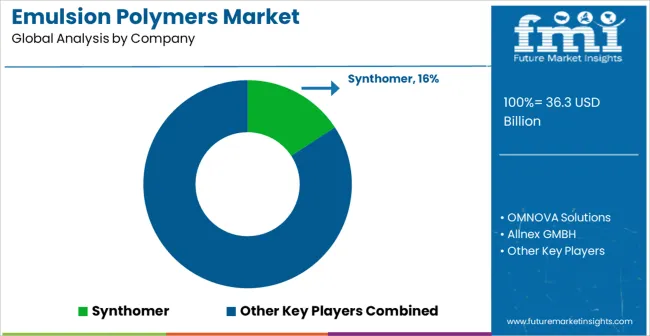The Emulsion Polymers Market is estimated to be valued at USD 36.3 billion in 2025 and is projected to reach USD 68.2 billion by 2035, registering a compound annual growth rate (CAGR) of 6.5% over the forecast period.

| Metric | Value |
|---|---|
| Emulsion Polymers Market Estimated Value in (2025 E) | USD 36.3 billion |
| Emulsion Polymers Market Forecast Value in (2035 F) | USD 68.2 billion |
| Forecast CAGR (2025 to 2035) | 6.5% |
The Emulsion Polymers market is growing steadily, supported by its increasing use across diverse end-user industries including paints and coatings, textiles, paper, and adhesives. Rising demand for water-based polymers as a sustainable alternative to solvent-based formulations is a major driver, given the tightening global regulations on volatile organic compound emissions. Their low toxicity, high performance, and environmental benefits are contributing to rapid adoption across industrial and commercial applications.
The market is further propelled by expanding construction activities, growth in textile manufacturing, and rising demand for high-performance coatings in automotive and packaging sectors. Technological advancements in polymerization processes are enhancing product quality, durability, and customization for industry-specific needs. Moreover, the ongoing shift toward bio-based emulsion polymers is reinforcing long-term growth opportunities, aligning with sustainability and circular economy goals.
Emerging markets are also witnessing accelerated adoption due to growing industrialization and infrastructure investments As industries continue to pursue eco-friendly solutions without compromising performance, the Emulsion Polymers market is expected to maintain strong momentum, driven by regulatory compliance, cost-effectiveness, and continuous innovation in product development.
The emulsion polymers market is segmented by application, product type, and geographic regions. By application, emulsion polymers market is divided into Textile, Inks, Paper And Paperboards, Paints And Coatings, Adhesives, and Others. In terms of product type, emulsion polymers market is classified into Acrylics, Vinyl Acetate Polymers, Styrene Butadiene Latex, and Others. Regionally, the emulsion polymers industry is classified into North America, Latin America, Western Europe, Eastern Europe, Balkan & Baltic Countries, Russia & Belarus, Central Asia, East Asia, South Asia & Pacific, and the Middle East & Africa.

The textile application segment is projected to hold 35.6% of the market revenue in 2025, establishing itself as a leading end-use category. Growth in this segment is being driven by the rising need for high-performance binders, coatings, and finishes that improve fabric durability, aesthetics, and comfort. Emulsion polymers are extensively used in textile processing for applications such as pigment printing, back-coating, flocking, and fabric finishing, where they deliver strong adhesion, flexibility, and resistance to wear and washing.
Their water-based formulation reduces environmental impact and aligns with global sustainability initiatives, which is increasingly important for textile manufacturers under regulatory and consumer pressure. The demand for advanced textile products, including technical textiles and nonwoven fabrics, is further contributing to segment expansion.
Additionally, the ability to modify polymer properties through formulation innovations allows manufacturers to develop tailored solutions for specialized textile applications As the global textile industry continues to expand, particularly in Asia-Pacific and other emerging economies, emulsion polymers are expected to remain integral to production processes, reinforcing the segment’s strong position in the market.

The acrylics product type segment is anticipated to account for 41.2% of the Emulsion Polymers market revenue in 2025, making it the leading product category. This dominance is being reinforced by the superior performance characteristics of acrylic-based polymers, including high weather resistance, transparency, and adhesion properties. Their versatility makes them widely applicable across paints, coatings, adhesives, and construction materials, where long-lasting durability and aesthetic appeal are critical.
Acrylic emulsion polymers are particularly favored in waterborne coatings due to their low volatile organic compound content, aligning with global regulatory standards and sustainability objectives. The growing use of acrylics in architectural coatings, automotive finishes, and packaging solutions further drives demand. Innovation in polymer chemistry is enabling the development of high-performance acrylic emulsions with enhanced properties such as UV resistance and flexibility, broadening their application scope.
Cost-effectiveness and compatibility with a wide range of additives and fillers also make acrylics highly attractive to manufacturers As industries increasingly shift toward environmentally friendly and high-performance solutions, the acrylics segment is expected to consolidate its leadership, contributing significantly to overall market growth.
Regulatory bodies such as REACH (Registration, Evaluation, Authorization and restriction of Chemicals) and EPA (Environmental Protection Agency) have been taking immense efforts in framing stringent rules for increasing usage of bio-based products, thereby minimizing noxious impacts on environment.
These standards have been framed under CAA (Clean Air Act) for controlling toxic chemical emissions and such initiatives have been enabling in promotion of emulsion polymers that are water-based.

| Country | CAGR |
|---|---|
| China | 8.8% |
| India | 8.1% |
| Germany | 7.5% |
| Brazil | 6.8% |
| USA | 6.2% |
| UK | 5.5% |
| Japan | 4.9% |
The Emulsion Polymers Market is expected to register a CAGR of 6.5% during the forecast period, exhibiting varied country level momentum. China leads with the highest CAGR of 8.8%, followed by India at 8.1%. Developed markets such as Germany, France, and the UK continue to expand steadily, while the USA is likely to grow at consistent rates. Japan posts the lowest CAGR at 4.9%, yet still underscores a broadly positive trajectory for the global Emulsion Polymers Market. In 2024, Germany held a dominant revenue in the Western Europe market and is expected to grow with a CAGR of 7.5%. The USA Emulsion Polymers Market is estimated to be valued at USD 12.5 billion in 2025 and is anticipated to reach a valuation of USD 12.5 billion by 2035. Sales are projected to rise at a CAGR of 0.0% over the forecast period between 2025 and 2035. While Japan and South Korea markets are estimated to be valued at USD 1.9 billion and USD 1.3 billion respectively in 2025.

| Item | Value |
|---|---|
| Quantitative Units | USD 36.3 Billion |
| Application | Textile, Inks, Paper And Paperboards, Paints And Coatings, Adhesives, and Others |
| Product Type | Acrylics, Vinyl Acetate Polymers, Styrene Butadiene Latex, and Others |
| Regions Covered | North America, Europe, Asia-Pacific, Latin America, Middle East & Africa |
| Country Covered | United States, Canada, Germany, France, United Kingdom, China, Japan, India, Brazil, South Africa |
| Key Companies Profiled | Synthomer, OMNOVA Solutions, Allnex GMBH, Arkema, DIC CORPORATION, BASF SE, Celanese Corporation, Wacker Chemie AG, Momentive, Mallard Creek Polymers, and Solvay |
The global emulsion polymers market is estimated to be valued at USD 36.3 billion in 2025.
The market size for the emulsion polymers market is projected to reach USD 68.2 billion by 2035.
The emulsion polymers market is expected to grow at a 6.5% CAGR between 2025 and 2035.
The key product types in emulsion polymers market are textile, inks, paper and paperboards, paints and coatings, adhesives and others.
In terms of product type, acrylics segment to command 41.2% share in the emulsion polymers market in 2025.






Our Research Products

The "Full Research Suite" delivers actionable market intel, deep dives on markets or technologies, so clients act faster, cut risk, and unlock growth.

The Leaderboard benchmarks and ranks top vendors, classifying them as Established Leaders, Leading Challengers, or Disruptors & Challengers.

Locates where complements amplify value and substitutes erode it, forecasting net impact by horizon

We deliver granular, decision-grade intel: market sizing, 5-year forecasts, pricing, adoption, usage, revenue, and operational KPIs—plus competitor tracking, regulation, and value chains—across 60 countries broadly.

Spot the shifts before they hit your P&L. We track inflection points, adoption curves, pricing moves, and ecosystem plays to show where demand is heading, why it is changing, and what to do next across high-growth markets and disruptive tech

Real-time reads of user behavior. We track shifting priorities, perceptions of today’s and next-gen services, and provider experience, then pace how fast tech moves from trial to adoption, blending buyer, consumer, and channel inputs with social signals (#WhySwitch, #UX).

Partner with our analyst team to build a custom report designed around your business priorities. From analysing market trends to assessing competitors or crafting bespoke datasets, we tailor insights to your needs.
Supplier Intelligence
Discovery & Profiling
Capacity & Footprint
Performance & Risk
Compliance & Governance
Commercial Readiness
Who Supplies Whom
Scorecards & Shortlists
Playbooks & Docs
Category Intelligence
Definition & Scope
Demand & Use Cases
Cost Drivers
Market Structure
Supply Chain Map
Trade & Policy
Operating Norms
Deliverables
Buyer Intelligence
Account Basics
Spend & Scope
Procurement Model
Vendor Requirements
Terms & Policies
Entry Strategy
Pain Points & Triggers
Outputs
Pricing Analysis
Benchmarks
Trends
Should-Cost
Indexation
Landed Cost
Commercial Terms
Deliverables
Brand Analysis
Positioning & Value Prop
Share & Presence
Customer Evidence
Go-to-Market
Digital & Reputation
Compliance & Trust
KPIs & Gaps
Outputs
Full Research Suite comprises of:
Market outlook & trends analysis
Interviews & case studies
Strategic recommendations
Vendor profiles & capabilities analysis
5-year forecasts
8 regions and 60+ country-level data splits
Market segment data splits
12 months of continuous data updates
DELIVERED AS:
PDF EXCEL ONLINE
Styrene Acrylic Emulsion Polymers Market Size and Share Forecast Outlook 2025 to 2035
Emulsion Stabilizers Market Size and Share Forecast Outlook 2025 to 2035
Emulsion Explosive Market Growth – Trends & Forecast 2025 to 2035
Meat Emulsions Market Growth - Demand & Industry Insights 2025 to 2035
Flavor Emulsions Market Size and Share Forecast Outlook 2025 to 2035
Bakery Emulsions Market Analysis - Size, Share, and Forecast Outlook 2025 to 2035
Flavor Emulsion Market Analysis by Nature, End-Use, Distribution Channel, and Region - Growth, trends and forecast from 2025 to 2035
Acrylic Emulsions Market Size and Share Forecast Outlook 2025 to 2035
Bitumen Emulsion Plants Market Size and Share Forecast Outlook 2025 to 2035
Polymer Emulsions Market Size and Share Forecast Outlook 2025 to 2035
Polymer Emulsion Market Growth - Trends & Forecast 2025 to 2035
Beverage Emulsion Market Analysis - Size, Share, and Forecast Outlook 2025 to 2035
UK Polymer Emulsion Market Insights – Size, Share & Industry Growth 2025-2035
Modularised Emulsion Plant Market Size and Share Forecast Outlook 2025 to 2035
USA Polymer Emulsion Market Report – Trends, Demand & Industry Forecast 2025-2035
Non-Silicone Emulsion Defoamer Market Size and Share Forecast Outlook 2025 to 2035
Adaptive Microemulsions Market Analysis - Size and Share Forecast Outlook 2025 to 2035
Japan Polymer Emulsion Market Outlook – Share, Growth & Forecast 2025-2035
ASEAN Polymer Emulsion Market Analysis – Demand, Size & Trends 2025-2035
Germany Polymer Emulsion Market Analysis – Growth, Trends & Outlook 2025-2035

Thank you!
You will receive an email from our Business Development Manager. Please be sure to check your SPAM/JUNK folder too.
Chat With
MaRIA